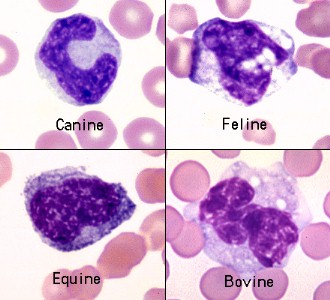Monocytes are extremely variable in appearance but there are no consistent species
differences. Each of the four monocytes shown here as examples are from different species
 but all could be found in blood of any individual animal of any species. For example, the
canine monocyte shown here would feel equally at home in a smear of horse blood and
the cat monocyte could have been in dog blood.
but all could be found in blood of any individual animal of any species. For example, the
canine monocyte shown here would feel equally at home in a smear of horse blood and
the cat monocyte could have been in dog blood.
Some monocytes resemble band or segmented neutrophils, as illustrated by the canine moncyte, while others, like this equine monocyte, may be mistaken for lymphocytes. In general, monocytes are recognized as cells that have abundant light to deep blue cytoplasm and nuclei that are not round. Chromatin is reticular or only slightly condensed. Most are larger than neighboring neutrophils and lymphocytes. Small pink granules are visible in some monocytes and many monocytes have several small discrete vacuoles. Nuclear shape amongst monocytes ranges from ameboid to bean-shaped to band-like to almost segmented. The texture of cytoplasm in a monocyte is slightly grainy or coarse compared to lymphocyte cytoplasm, which is very smooth and glassy. |
Last updated on Saturday, February 10, 1996